Search Results
Fine Jewelry University Articles matching: “Ring gemstone”
Showing only FJU Article results. Click here to show all results.
Fine Jewelry University (Show All FJU Articles)
-
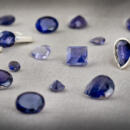
Gem in the Spotlight: Iolite
Iolite is maybe not the first gemstone people think of for their blue-violet jewelry, but it should be near the top of the list. Iolite’s color range of … color of the stone when it was first discovered. This adds value to many gem buyers who don’t want a treated gemstone. Color Me Impressed Iolite is strongly pleochroic and will exhibit a different color when viewed at different angles. … is caused by differing absorption of light rays in doubly refractive crystals. Thus, no singly refractive gemstone can exhibit pleochroism. The process works because of the ability of a gem to absorb different wavelengths of transmitted …
-
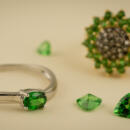
Gem in the Spotlight: Tsavorite Garnet
…and lively with a high refractive index giving it excellent sparkle and scintillation. Tsavorite is also a very rare gemstone. It is uncommon to find Tsavorite in sizes larger than five carats, and most faceted stones are below two carats. By… grossularite doesn’t exactly roll off the tongue. So, a proper name was definitely in order. The nomenclature of gemstones follows certain rules, and according to modern mineralogical methods, gemstones are given a name which ends in “-ite…
-
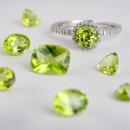
Gem in the Spotlight: Peridot
Peridot is a lovely yellow-green gem with a rich history. Legend has it that Peridot was the favorite gemstone of Cleopatra. The ancients called it the “gem of the sun”. It was believed that peridot could chase away evil …dissolve curses but only when set in gold. Peridot is the birthstone for August. It is also the accepted anniversary gemstone for the 16th year of marriage. Peridot’s unique yellow-green color is very attractive. The name “Peridot” is simply …
-
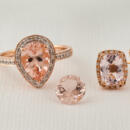
Gem in the Spotlight: Morganite
Morganite is a beautiful, soft pink gemstone and a graceful expression of elegance. It is not a very well-known gem, but it definitely should be. It is pastel or…salmon. It is the subtle, understated nature of Morganite’s color that sets it apart from many of the more popular gemstones. Morganite has an impressive family tree. It is a beryl gem which puts it in the same family as emerald and … pink variety of beryl “Morganite”. It has good hardness, durability, luster, and brilliance which make it a great gemstone for jewelry. For the gem nerds out there, here are a few of the gemological properties of Morganite. Its durability is…
-
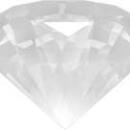
Fake Diamonds: The Great Diamond Attack
… made in a factory. Yes, they can make synthetic diamonds and have for many years now. Most are used in the manufacturing of tools like diamond tip drills. Synthetic diamond crystal big and pretty enough for jewelry has been made since … too much to justify using them. The technology is becoming more cost effective, and some synthetic diamonds are entering the market place now. Since they are the same chemistry as natural diamond, there is no easy test to use to separate…
-
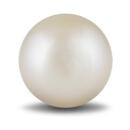
Gem in the Spotlight: Pearl
… changed hands many times, and was owned by several famous figures, including Napoleon III and Elizabeth Taylor. During Taylor’s ownership, the pearl was set into a necklace designed by Cartier, which also included diamonds and rubies. … once part of a larger piece of jewelry that also included the Hope Diamond, and that the two gems were separated during the French Revolution. Today, the Hope Pearl is owned by a private collector and is occasionally displayed at museums…
-

How to Tell If a Diamond Is Natural or Lab Grown
…, 100% sure whether a diamond is lab grown or natural, you can send it to specialized gem labs for testing. DeBeers and GIA (the Gemological Institute of America) have developed even more complex and sophisticated machines for answering this question. They have imaginative names like DiamondCheck, DiamondSure, and DiamondView. Roughly speaking, these machines work like our DiaTrue. They bombard a diamond with specific types of radiation (nothing harmful to humans) and …
-
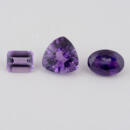
Gem in the Spotlight: Amethyst
… as hard as tourmaline, softer than sapphire and topaz, and harder than opal and tanzanite. This makes it a durable gemstone that is resistant to scratching and chipping. It is also resistant to heat and chemicals which means that it can … tears of wine in remorse for his actions. These tears stained the quartz purple, resulting in the creation of the gemstone known as amethyst. Amethyst has a long history of being used in jewelry and other decorative items. It was highly …
-
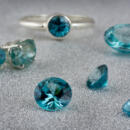
Gem in the Spotlight: Blue Zircon
Zircon may be last in the alphabet of gemstones, but it is first in sparkle. The crystal structure of zircon creates one of the liveliest displays found in any … then other colored gems? Zircon has a high refractive index (1.92-2.01). The refractive index (abbreviated RI) of a gemstone is its optical property that refers to the ratio of the speed of light in a vacuum to the speed of light through a …. Brown zircons can be transformed into colorless or blue zircons through heat treatments. Zircon is a durable gemstone with good hardness on the Mohs scale (6 to 7.5). However, Zircon has what is known as indistinct cleavage which creates a…